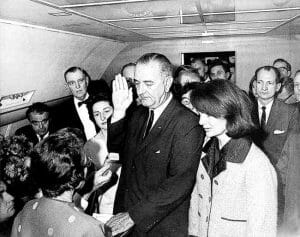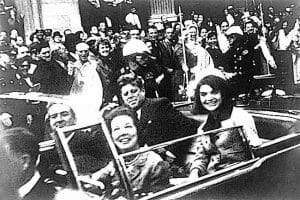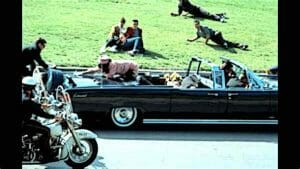Kennedy Assassination
Introduction
On November 22, 1963, President John F. Kennedy was assassinated during a trip to Texas. Kennedy was serving as the 35th President of the United States at the time. He was shot and assassinated as he traveled with a motorcade through the Dealey Plaza in Texas. Kennedy’s assassination shocked the nation and remains one of the most controversial moments of American history.
Background
President John F. Kennedy hadn’t garnered a lot of support from Texas during the presidential elections. Following his victory, many Democratic Party members in Texas began squabbling between themselves.
President Kennedy wanted to reconcile the party members and gain more support in Texas. This trend was all the more true for Dallas. President Kennedy and Vice President Johnson had lost the city of Dallas in the presidential elections, although they did win the elections.
The President hoped to be able to raise more support and funds for his party, and the upcoming presidential elections, through his Texas visit.

The Route of the Motorcade
During the Texas visit, President John F. Kennedy wanted maximum exposure to public. This was in order to garner public support and connect with the people. It was with this in mind that his motorcade route was planned to pass through several areas of Dallas.
These were public areas where people lined the route to catch a glimpse of the president. Kennedy and his motorcade entered the Dealey Plaza at 12:30 p.m. President Kennedy was seated in an open-top 1961 Lincoln Continental. Texas Governor John Connally and his wife sat in the front seat while President Kennedy and his wife, Jacqueline Kennedy, sat in the rear seat.
Shooting and Assassination
As Kennedy’s motorcade drove across the Dealey Plaza, shots were fired. A total of three shots were fired by the assassin. Of these, the first shot hit President Kennedy and seriously wounded. It was soon followed by a second shot that bypassed Kennedy and hit Governor Connally instead.
The assassin then shot a third time, this time hitting the President in the head. The third shot proved fatal. The witnesses heard the gunshots at the scene. Secret service agents rushed to shield the car and protect the president but by then it was too late.
Death and Funeral of President Kennedy
After the shots and the fatal wounds of the president, the motorcade was rushed to the Parkland Memorial Hospital. The second shot that hit President Kennedy in the head proved to the fatal. Merely 30 minutes after the shots, President Kennedy was pronounced dead at the hospital.
His body was then taken from the hospital and placed on board Air Force One to be flown back to Washington. In Washington, a three-day state funeral for President Kennedy took place. Hundreds of thousands of people gathered up to take a final look at the assassinated president.
Worldwide Reaction
The entire American nation was stunned by the assassination of John F. Kennedy. Kennedy had a strong and loyal support in the northern states, although he was less popular in the South. People gathered up in public to hear the news. Many wept and all public life effectively came to a halt.
In the South, some people jubilated over the death of President Kennedy. The assassination created resentment against Texas and Texans – many Americans saw them as responsible for Kennedy’s assassination. The worldwide reaction to the assassination was also that of shock and grief. Memorials in memory of the president were arranged around the world.

Arrest of Lee Oswald
Lee Harvey Oswald was charged with the assassination of President John F. Kennedy. Another eyewitness had seen Oswald shooting from the building of the Texas School Book Repository. Based on the reports of the eyewitnesses, Dallas police started a search for Oswald. During the attempts to arrest him, Oswald shot and murdered a police officer. He was subsequently apprehended and charged with both crimes.
Before Oswald could be tried in a court of law, he was shot at close range by Jack Ruby. Ruby shot Oswald as he was escorted by the police for transfer from city jail to county jail. Jack Ruby was later convicted of killing Oswald and died during his prison term. Many allege that Ruby and Oswald were part of a wider conspiracy to assassinate the President.
Evidence from the Assassination
A number of photographs and other forms of evidence exist from the event of President Kennedy’s assassinations. Many photographs show President Kennedy just before the fateful shooting. Some photographs also show the President after he was hit by the first shot. Another photograph shows the secret service agents jumping onto the car to shield the president. The available evidence and their usage later proved instrumental in casting a controversial light on the investigations.

Lyndon-B-Johnson-Becomes-President-after-the-Kennedy-Assasination-taking-oath-of-office-November-1963.jpg
Investigation by the authorities
Investigation of the assassination was conducted by multiple bodies. The initial report by the FBI blamed Lee Harvey Oswald for the assassination. This was confirmed by the Warren Commission constituted by President Lyndon B. Johnson to investigate the assassination.
However, it was later alleged that the FBI withheld important evidence from its report and from the commission. Consequently, this cast the findings of both in a negative light. Subsequent investigations were conducted by the Rockefeller Commission in 1975, the House Committee on Assassinations from 1976 to 1978 and the Assassination Records Review Board.
Conspiracy theories
Some of the investigations concluded that the possibility of a conspiracy had been insufficiently investigated. FBI and CIA had controversially withheld evidence which proved important. Many eye witnesses or related witnesses of the event suffered mysterious accidental deaths. These mysterious deaths number from 50 to over 100, according to some researchers.
As a result of these inconsistencies, the assassination of John F. Kennedy remains one of the most controversial events of American history. Nearly 80% Americans still believe that the assassination was a result of a conspiracy that has not yet been unearthed. Many continue to demand further investigations into the event.

